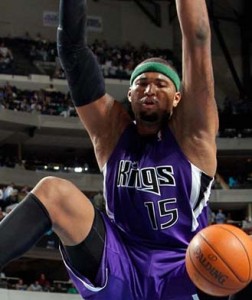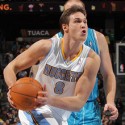 The NBA is currently mid-stage in one of its follow-the-leader transitions. This era has been in process for several years. Previously it was called position-less basketball; today we’re calling it small ball.
The NBA is currently mid-stage in one of its follow-the-leader transitions. This era has been in process for several years. Previously it was called position-less basketball; today we’re calling it small ball.
Driving the trend is the success of recent champions who essentially played without a true Center — at least not at crunch time. As a result, the past offseason has even more teams planning to go small: Power Forwards lining up at C and Small Forwards having to play PF, sometimes against their wishes. Every team plans on using lineups with two Point Guards.
As a result of this real-world shift, the fantasy landscape is changing too. There are more starting Shooting Guards putting up PG-like stats (I call them pseudo-Points) than ever. Almost all PFs shoot the three and show a perimeter game. More and more C-eligible players have 3-point range, too. Ryan Anderson, you are no longer a man on an island.
Multiple-position eligibility in fantasy used to be more desirable. Now that most players have it, you should be focused more than ever on drafting skills over positions.
Positionless Drafting
When evaluating players, I like to squeeze them into one of three categories I call Points, Wings and Bigs, based on their skills, not traditional positions.
 Points are the prime providers of assists, steals and FT%, even better if they can add points and threes. They almost always have PG eligibility, with a few exceptions like Andre Iguodala, Josh McRoberts and Boris Diaw.
Points are the prime providers of assists, steals and FT%, even better if they can add points and threes. They almost always have PG eligibility, with a few exceptions like Andre Iguodala, Josh McRoberts and Boris Diaw.
Bigs are the prime providers of rebounds, blocks and FG%, even better if they add PTS and STL.
Wings are the prime providers of 3-pointers though they should contribute across the board. They can usually be broken down further by their efficiency.
Efficient Wings shoot high percentages in FG% and FT% but usually under-perform in the counting areas (think J.J. Redick.)
Volume Wings, whose percentages leave something to be desired, rack up those counting stats (think peak Lance Stephenson.) In addition to SG-SF, I often shift PG who don’t pass, like Brandon Knight, to the Wing category.
Players who defy these categories, like Rajon Rondo (PG with low FT%) or Roy Hibbert (C with low FG%) or even a healthy Michael Kidd-Gilchrist (SF who doesn’t shoot 3’s) do not end up on any of my teams.
I highly favor Points with higher FG% over those with lower ones — George Hill gets upgraded, Kemba Walker gets downgraded. Among Bigs, I highly favor those with reasonable FT% over those who subterfuge you, so Jonas Valanciunas gets upgraded, Andre Drummond gets downgraded. Among Wings, I look for balance between efficiency and counting categories.
With all that in mind, let’s quickly break down the position landscape.
Points
I see a distinct elite tier of in Stephen Curry, Chris Paul, John Wall, Russell Westbrook and Damian Lillard, each of whom will be drafted in the first round. Unless a James Harden or Kevin Durant falls, I am almost assuredly drafting a Point with my first pick in a 20-team snake draft.
 Behind them are seven roughly equal options: Kyrie Irving (depending on his health), Reggie Jackson, Goran Dragic, Kyle Lowry, Mike Conley and Jeff Teague. If I can’t get one of the elites with my first pick, I am definitely grabbing one from this tier and even if I do get an elite PG, I’ll take any from the second tier who falls into the third round, most likely Jackson, the cheapest of the group.
Behind them are seven roughly equal options: Kyrie Irving (depending on his health), Reggie Jackson, Goran Dragic, Kyle Lowry, Mike Conley and Jeff Teague. If I can’t get one of the elites with my first pick, I am definitely grabbing one from this tier and even if I do get an elite PG, I’ll take any from the second tier who falls into the third round, most likely Jackson, the cheapest of the group.
After that I see a bunch of flawed options (whether it be age, playing time, health or shooting woes) that I would let others pick through. That said, Isaiah Thomas, Ty Lawson and Emmanuel Mudiay are my favorites among the rest and represent nice mid-round targets. As do pseudo-Points C.J. McCollum, Jordan Clarkson, Alec Burks and Zach LaVine.
In terms of late-round flyers, it is always good strategy to target quality backups of weak starters. Consider Darren Collison, Greivis Vasquez and Mo Williams.
Wings
It’s heavy at the top with Harden, Durant, LeBron James and Jimmy Butler all deserving of a first round pick. The middle tier is actually quite small — Paul George, Gordon Hayward, Kawhi Leonard, Klay Thompson and Victor Oladipo. At about this point my rankings diverge significantly from consensus. I will avoid spending early picks on wings, because there is a lot of value in the middle to late rounds.
 There is so much turnover in the wing positions and so much new talent being added, that under-appreciated vets and undervalued breakouts will be available later, at little to no difference in value from the consensus choices. My personal favorites include Otto Porter, T.J. Warren, Rodney Hood, Danilo Gallinari, J.R. Smith, Wilson Chandler, Jae Crowder and Stanley Johnson. Even veteran players like Arron Afflalo, Luol Deng and Thabo Sefolosha should have no problem exceeding their draft cost.
There is so much turnover in the wing positions and so much new talent being added, that under-appreciated vets and undervalued breakouts will be available later, at little to no difference in value from the consensus choices. My personal favorites include Otto Porter, T.J. Warren, Rodney Hood, Danilo Gallinari, J.R. Smith, Wilson Chandler, Jae Crowder and Stanley Johnson. Even veteran players like Arron Afflalo, Luol Deng and Thabo Sefolosha should have no problem exceeding their draft cost.
Bigs
Because Bigs are getting fewer and fewer minutes, you must draft them early to get a good one. I would be looking to draft two Bigs with my first four picks. My favourites in the top 50 are Serge Ibaka, Chris Bosh, Greg Monroe, Marcin Gortat and Jonas Valanciunas. I try to avoid the low FT% types, which adds extra incentive to grab the others before they are gone.
Some of the more boring names, like Robin Lopez, Timofey Mozgov, Tyson Chandler, Ed Davis and Gorgui Dieng, make good targets in the middle rounds. At the end of the typical draft, the state of the Bigs is pretty sad, with names like Jordan Hill, Nene Hilario and Omer Asik. Stay far away from that type and instead focus on high-upside guys like Myles Turner, Meyers Leonard, Alex Len or Donatas Motiejunas, whose roles are evolving.